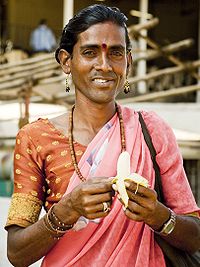Hidzsra (India)
 | Ez a szócikk a dél-ázsiai közösség szól. Hasonló címmel lásd még: Hidzsra (egyértelműsítő lap). |

A hidzsrák (hindiül: हिजड़ा) kifejezés az indiai szubkontinens területén élő transzszexuálisokra, illetve transzneműekre utal.[1][2]
Gyakori tévedés, hogy a hidzsrák csak férfiak lehetnek női identitástudattal, női szerepeket vállalva és női ruhákat viselve. A valóságban a közösség ennél sokszínűbb. Pakisztánban a hidzsrák lehetnek nők, férfiak és „harmadik neműek” is. A legtöbben férfiként jönnek világra, ám felnőttkorukban sokan végleg megszabadulnak nemi szerveiktől.[3][4]
Sok hidzsra szervezett, kizárólagos hidzsra közösségekben él, melyeket egy guru vezet.[5][6] Ezek a közösségek generációkon át fiatal fiúk adoptálása révén tartották fenn magukat.[7]
Sokan közülük zsarolás (munka, ill. mindennapi élet megzavarása), szertartásoknál történő előadások, koldulás, ill. prostitúció révén szereznek jövedelmet.[3][8] A hidzsrák kifejlesztettek egy titkos nyelvet is hidzsra-fárszi néven, mely valójában nem a perzsa, hanem az urdu nyelven alapul, továbbá egy kb. ezres saját szókészlete van.
Indiában hetven-százmillió meleg él (2009).[3] 2014 áprilisában az indiai Legfelsőbb Bíróság törvényben ismerte el a hidzsrákat mint a „harmadik nem” képviselőit.[9][10]
Források
- ↑ Choksi, Mansi. „The Ties that Bind Transgendered Communities”, The New York Times, 2013. december 19. (Hozzáférés: 2014. február 7.)
- ↑ „Lesbian, Gay, Bisexual and Transgender Communities in India”, Angloinfo; the Global Expat Network INDIA. [2014. február 20-i dátummal az eredetiből archiválva] (Hozzáférés: 2014. február 7.)
- ↑ a b c Transzneműek Indiában, Magyar Narancs, 2009/27., Linder Bálint
- ↑ Diane P. Mines, Sarah Lamb: Everyday Life in South Asia, Indiana University Press, 2010, p. 124, ISBN 9780253354730
- ↑ Serena Nanda, "The hijras of India: Cultural and Individual Dimensions of an Institutionalized Third Gender Role", Journal of Homosexuality 11 (1986): 35–54.
- ↑ L Cohen, "The Pleasures of Castration: the postoperative status of hijras, jankhas and academics", Paul R. Abramson, Steven D. Pinkerton (szerkesztők), Sexual Nature, Sexual Culture c. művében, (University of Chicago Press, 1995).
- ↑ RB Towle, és LM Morgan: "Romancing the Transgender Native: Rethinking the Use of the 'Third Gender' Concept", S. Stryker és S. Whittle (szerkesztők) Transgender Studies Reader c. művében, (Routledge, 2006), 116. o.
- ↑ Serena Nanda, Neither man nor woman: The hijras of India, Hijra roles in Indian Society c. fejezet, 1-9. o., Wadsworth Pub. Co.
- ↑ India recognises transgender people as third gender, The Guardian, 2014. ápr. 15.
- ↑ Hope and anger in transgender community, BBC News, 2014 ápr. 23
Művek a témáról
- Agrawal, Anuja. "Gendered Bodies: The Case of the 'Third Gender' in India". In Contributions to Indian Sociology, új sorozat, 31 (1997): 273–97.
- Ahmed, Mona és Dayanita Singh (fotós). Myself Mona Ahmed. Scalo Publishers, 2001. ISBN 3-908247-46-2
- Bakshi, Sandeep. "A Comparative Analysis of Hijras and Drag Queens: The Subversive Possibilities and Limits of Parading Effeminacy and Negotiating Masculinity.” Ed. Stephen Hunt, Religions of the East. Surrey: Ashgate, 2010.
- Gannon, Shane Patrick. Translating the hijra: The symbolic reconstruction of the British Empire in India. PhD-munka. University of Alberta, 2009.
- Jami, Humaira. "Condition and Status of Hijras (Transgender, Transvestites etc.) in Pakistan", National Institute of Psychology, Quaid-i-Azam University (2005?)
- Malloy, Ruth Lor, Meen Balaji and others. Hijras: Who We Are. Toronto: Think Asia, 1997.
- Money, John. Lovemaps. Irvington Publishers, 1988. 106. o. ISBN 0-87975-456-7
- Nanda, Serena. Neither Man Nor Woman: The Hijras of India. Wadsworth Publishing, 1998. ISBN 0-534-50903-7
- Patel, Geeta. Home, Homo, Hybrid: Translating Gender. In A Companion to Postcolonial Studies. Malden MA: Blackwell, 2000. 410-27.
- Reddy Gayatri 'Men' Who Would Be Kings: Celibacy, Emasculation, and the Re-Production of Hijras in Contemporary Indian Politics, 2003, Social Research, 70. évfolyam, 1. szám, 163–200. o.
- Reddy Gayatri With Respect to Sex: Negotiating Hijra Identity in South India, 2005, Chicago, University of Chicago
- Zipfel, Isabell ' 'Hijras, the third sex' ' eKönyv 34 fényképpel
Külső hivatkozások
Hijra: India's third gender claims its place in law, The Guardian, Homa Khaleeli, 2014, ápr. 16. (angolul)







